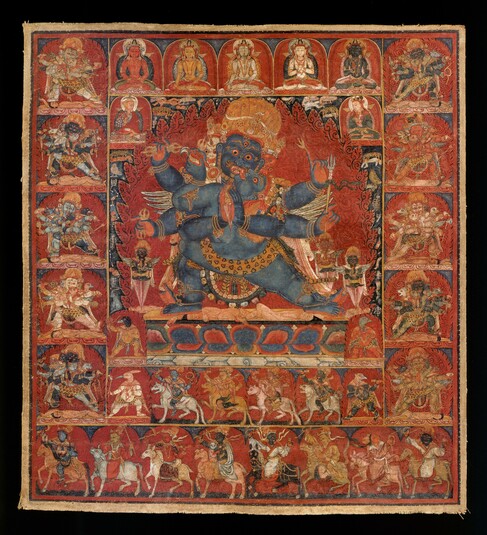
Item: Vajrakila (Eight Pronouncements)
| Origin Location | Tibet |
|---|---|
| Date Range | 1300 - 1399 |
| Lineages | Nyingma and Buddhist |
| Material | Ground Mineral Pigment on Cotton |
| Collection | Private |
Classification: Deity
Vajrakila and retinue deities according to the Revealed Treasure tradition of the Nyingma School of Tibetan Buddhism. (See a Kalachakra Vajravali painting with a similar composition, colour palette and date).
Vajrakila is a wrathful meditational deity with three faces, six arms and four legs. He is blue in colour along with the central face. The proper right face is white and the left red. The two main hands roll a vajra peg between the palms. The upper two right hands also hold vajra scepters. The upper two left hands hold a katvanga staff with a trident tip and a mass of flame. He embraces the goddess Dipta Chakra and stands in a circle of red flames. Above to the right and left sides are Padmasambhava and Yeshe Tsogyal. Along side the throne are two figures with kila lower bodies and below those are two animal-headed figures.
"...the king of wrath, bhagavan Vajrakumara, with a body blue-black [in colour], three faces and six hands. The right face is white, left red, the center blue. Held with the two pairs of right and left hands are a nine and five pointed vajra, a blazing mass of fire and a trident. The remaining two roll a kila. The body is huge and heavy, with bared fangs, three eyes - round and red, brown hair flowing upward; wearing an elephant hide, human skin, and a tiger skin as a lower garment. Adorned with white, red, green, and black snakes as a crown, necklace and sash, decorating the arms and legs. Five dry skulls adorn the head. Wearing a garland of fifty fresh [heads], marked with clots of rakta, spots of great ash and a smear of grease, adorned with various jewel ornaments. With four legs the right are bent and left extended atop the head of Ishvara - face down, and the breast of Uma, standing in the middle of a massive fire of pristine awareness." (Sakya Ngawang Kunga Lodro, 1729-1783).
Along the top register are the Five Symbolic Buddhas: red Amitabha, yellow Ratnasambhava, blue Akshobhya, white Vairochana and green Amoghasiddhi. Each has one face and two hands seated in the vajra posture.
Descending in the right and left outer registers are ten surrounding retinue forms of Vajrakila that make up the circle of the mandala.
In the bottom two registers are various worldly deities that function as protectors for the meditational practice of Vajrakila.
Jeff Watt 2-2018
Front of Painting
English Translation of Inscription: No inscriptions.
Exhibition: Padmasambhava, the Second Buddha
Thematic Sets
Buddhist Deity: Vajrakila (Iconographic Forms)
Buddhist Deity: Vajrakila (Early Images)
Buddhist Deity: Vajrakila Religious Context
Buddhist Deity: Vajrakila Main Page
Subject: Meditational Deities (ishtadevata, yi dam)
Buddhist Deity: Vajrakila (Masterworks)
Subject: Wrathful Appearance Page
Padmasambhava: Early Images (Primary & Secondary)



